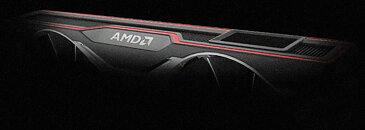Thursday, May 21st 2020

AMD RDNA2 Based Radeon RX Graphics Cards Launching This September
AMD's next-generation RDNA2 architecture based Radeon RX series client-segment graphics cards will launch in September 2020, according to a DigiTimes report citing industry sources. This would make September a mighty busy month for hardware launches, as the company is also expected to debut its 4th generation Ryzen "Vermeer" (and possibly "Renoir) desktop processors in the AM4 package. NVIDIA is expected to debut its GeForce "Ampere" client-segment graphics cards around the same time. Although not in the same computing segment, Intel could also debut its 11th generation Core "Tiger Lake" mobile processors.
RDNA2 is an important launch for AMD as it's the company's first graphics architecture that meets the DirectX 12 Ultimate logo requirements, which include real-time ray-tracing capability leveraging DXR, variable rate shading, mesh shaders, and sampler feedback. AMD and NVIDIA will be debuting their graphics cards close to the release of CD Projekt's "Cyberpunk 2077," which is emerging as the year's most hotly anticipated game.
Sources:
DigiTimes, via VideoCardz
RDNA2 is an important launch for AMD as it's the company's first graphics architecture that meets the DirectX 12 Ultimate logo requirements, which include real-time ray-tracing capability leveraging DXR, variable rate shading, mesh shaders, and sampler feedback. AMD and NVIDIA will be debuting their graphics cards close to the release of CD Projekt's "Cyberpunk 2077," which is emerging as the year's most hotly anticipated game.

70 Comments on AMD RDNA2 Based Radeon RX Graphics Cards Launching This September
Navi 22 with its 350 sq. mm and Navi 21 with 505 sq. mm have to be faster.
AMD line up doesn't follow the same order as nvidia were it's : Big server gpu first, and then cut down gaming gpu. RDNA was first used on a gaming gpu, then on workstation. The server side is still vega on 7 nm.
Arcturus doesn't come with RDNA2.
And RX 5700 XT is nothing but something like a small pipe-cleaner type of card for the N7-class process.
Why not ask Nvidia to do that and like Turing they launched the new generation GPU first. If Nvidia prices their gpus resonable AMD will have to do the same.Better than buying 2000$+ laptop with Turing gpu now when Ampere is just around the corner.
I'm not updated with gaming laptop upgradeability, but I assume MXM cards isn't really as common as it should be anymore.
There were 106 million PS4 and 46.9 million Xbox One consoles sold in total since their release in 2013. That's 7 years and counting and roughly 21 million per year. NVIDIA alone sold more than 15 million of their RTX GPUs since their release less than 2 years ago. And that's a higher end product (and even a more expensive than previous generations). Combined with lower end cards and those of AMD, PC hardware market seems just as big, if not bigger, than consoles. It is certainly more profitable (Nvidia's 65% margin speaks for itself).
Consoles are not an advatage for AMD. They help AMD survive, barely. They also suck a big portion of waffer allocation from AMD, that could have been otherwise sold in a more profitable PC or server market (if AMD was competitive, which it is not except for CPUs, unless RDNA2 changes that somehow).
- AMD has produced 150+ million of the exact same GPUs. That is volume. Turing is comprised of a whole range of cards: even two radically different designs, 20 and 16 series, with fundamentally different blocks in them. And yet, Nvidia still reaches about 1/5th of AMDs console chip sales.
- AMD has no limit on wafer allocation.. they buy in and price is factored into the product cost. But consoles do offer a long term contract that allows AMD to project demand way ahead of everyone else. Win win; fab gets work, AMD gets a lower price. And the design is always the same too.
www.notebookcheck.net/AMD-s-high-end-Navi-GPU-allegedly-pops-up-in-OpenVR-benchmark-outperforms-Nvidia-s-RTX-2080-Ti.449872.0.html
I mean short lifespan in my PEG slot, and that's it. You guys watching too much conspiracy theory :D
If you can't control the Itch, that's on you stop moaning:D.
And chips are directly linkable to aliens, we didn't have chip's before Bob lazar's mate's back engineering efforts on Aliens ships;) :p :D
AMD manufactured 150 million console chips OVER 7 YEARS. That is 21 million per year on average. Nvidia's statement about 15 million of their RTX GPUs (RTX 2060 and above, not inlcuding GTX 1660, 1650, etc.) came out in March this year (and was widely quoted on the net), as you can read here:
blogs.nvidia.com/blog/2020/03/23/dlss-2-ai-gaming-directx-12-ultimate/
RTX GPUs were released from 20th of September 2018 (RTX 2080) through 17th of October 2018 (RTX 2070) to 15th of January 2019 (RTX 2060), as you can read here:
en.wikipedia.org/wiki/GeForce_20_series
There was also a shortage of these cards initially, lasting to roughly January 2019. With the highest volume card (RTX 2060) release in mid January 2019, the initial shortages and the "15 million RTX GPUs sold" appearing in March 2020, it's easy to see that Nvidia sold those 15 million RTX GPUs roughly within a year. Add the lower end cards like GTX 1660, 1660ti, 1650 etc. and you can easily get to 21 million of GPUs sold, if not more.
In the retrospective, over those seven years since the consoles were released, Nvidia alone might have sold more chips than all the consoles together, especially if you think about sales generated by the cryptocurrency mining waves.Of course they do have waffer allocation limits. TSMC capacity is not infinite you know. And the 7nm capacity has to be shared among big players like Apple, Nvidia, AMD and others. And it is fully booked. Is that selective blindness on your part or what?
"TSMC 7nm capacity fully booked till 2H 2020": wccftech.com/amd-7nm-wafer-production-set-to-double-in-2h-2020-7nm-capacity-at-tsmc-currently-fully-booked/